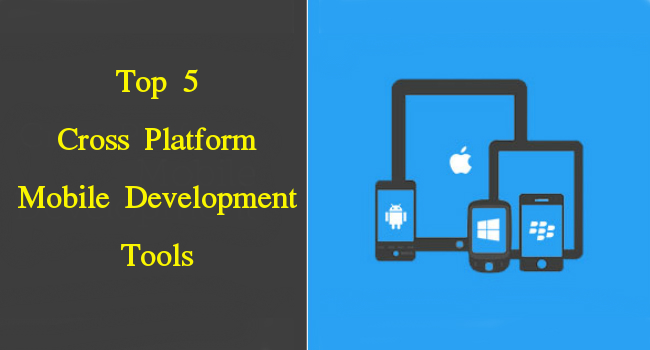Picking the right development tool is a critical part of building a good app. But there are certain factors that come into play when you’re trying to decide which tool is the best.

Often times, the platform that you want to build for dictates which types of tools you’ll be using. You’re going to use different tools depending on if you’re building for Apple or Android.
For the purpose of saving effort and time, the goal here is to create multi-platform apps with code reuse. To help you work on cross-platform mobile application development, here are the top 5 best cross-platform frameworks for developing mobile apps that work on multiple platforms including Android, iOS, Windows Phone, BlackBerry OS, etc.
Xamarin
In Xamarin, a C# codebase can be universally applied to multiple platforms. However, unlike other frameworks, it lets developers work with native IDEs, languages, and APIS. Moreover, Git integration is built directly into the Xamarin Studio.
Pros
- Xamarin comes up with some sample apps to help you get started in a quick and easy manner.
- Almost three-fourths of the code can be shared across major mobile platforms. Hence, using Xamarin, you can curtail not just the development cost but also the TTM (time-to-market).
- Xamarin supports functionality testing and quality monitoring across a wide range of devices. It does have its Android emulator.
Cons: Prevailing compatibility issues with open-source libraries for Android and iOS are a bit deterrent towards building a full-edged app. This is something that its community must address to encourage the development of a substantial project with Xamarin.
Convertigo
Convertigo is an open-source software vendor that provides a mobile enterprise application platform consisting of these solutions: Convertigo Studio, Convertigo Server, Convertigo Cloud, and Convertigo Mobilizer.
Pros:
- It lets you create business-driven events computed to notify users, even if the device is in stand by mode
- It allows connecting to enterprise data with a variety of connectors such as SQL databases or web services
- With its Fu||sync data replication technology, data can be made available locally even if the network is not accessible
Cons: Convertigo has three different plans. Of which, the free plan just has community support and doesn’t include its Fu||sync ofine data support.
Sencha Touch
Sencha Touch is a leading cross-platform mobile web app framework that can be used to build efficient applications making use of hardware acceleration techniques. On Sencha, top quality apps can be built with we||-tested, tightIy-integrated UI components, and libraries. It’s even capable of building large business applications and maintaining them with ease.
Pros:
- It offers bui|t-in native-Iooking themes for every major platform
- It supports Android, iOS, BlackBerry, Windows Phone and more
- It packs in an agnostic backend data package for working with data sources
- It supports PhoneGap/Cordova integration for native API access and packaging
Cons: Though Sencha Touch of'fers native-Iooking themes, the availability of themes is limited, of course. Moreover, its commercial licensing is difficult to understand.
Codename One
Codename One is a cross-device platform with goals of simple usability, rapid application development, deep integration with the native platform with possible native speeds. While you’re required to code in Java, your application can also be tested & verified with Codename One’s simulator devices and test automation tools.
Pros:
- It supports most of the popular IDEs like NetBeans, Eclipse, IntelliJ IDEA, etc.
- Its ‘Iightweight architecture’ allows the UI to work seamlessly across all platforms
- Its build servers a||ow building native iOS apps without a Mac machine and native Windows apps without a Windows PC
- It uses ParparVM which guarantees compatibility with future iOS versions because of its use of the officially supported iOS too|chain
Cons: Codename One’s default visual themes are a bit primitive and its Graphical UI Builder may not be very suitable for large projects. With growing project’s complexity, maintaining a single file with all event handlers become very cumbersome.
PhoneGap
Open source PhoneGap is a great option for building cross-platform mobile apps leveraging on existing web technologies. PhoneGap is best suited for mobile applications that don’t make substantial use of the phone’s native features. It packages your application within a native application container which allows JavaScript to access device-Ievel APIs the same way normal apps do.
Pros:
- It allows creating hybrid apps using popular web technologies (HTMLS, C553, and JavaScript), which are also readily available skill sets
- It lets you deploy a single code base to different platforms including iOS, Android, Windows Phone, BlackBerry, Firefox OS and more
- It follows a plugin-able architecture, which means that access to native device APIs and more can be extended in a modular way
- It enables you to make use of in-app, integrated payments via the App Store for iOS, the Google Play Store for Android and more
Cons: The performance is known to be a bit poor for graphic-intensive apps made using PhoneGap. Although you may easily nd plugins for PhoneGap per requirements, they could be somewhat outdated or unsupported based on the target platform(s).
Conclusion
Picking the right platform to develop for is one of the most critical parts of building your app.
But now, you’ve got the ability to build a cross-platform mobile app. This allows you to quickly and easily capitalize on the enormous audiences of both iOS and Android users. S0, you won’t have to worry about alienating certain groups and you’re not forced to develop for just one platform.
This will allow developers working in a cross-platform app development company in India and overseas to maximize the revenue. But in order to do this properly and efficiently, you’ll need to find the right cross-platform development tools available in the market.
This isn’t easy with so many options available in the market. So refer to the list above to strike a balance between what is available and what is required, and go in the right direction.
0 Comment(s)